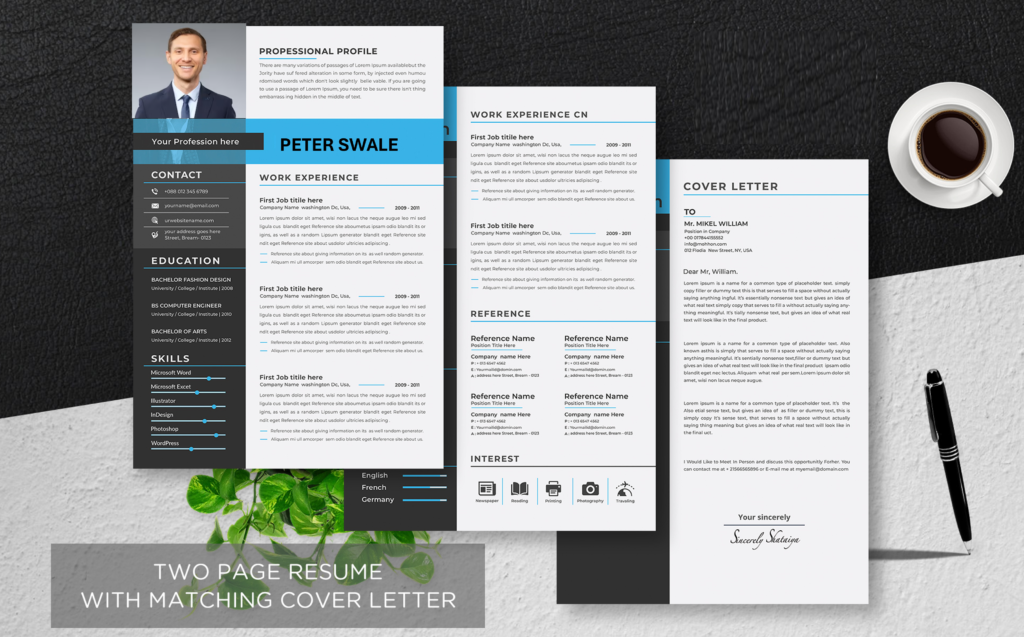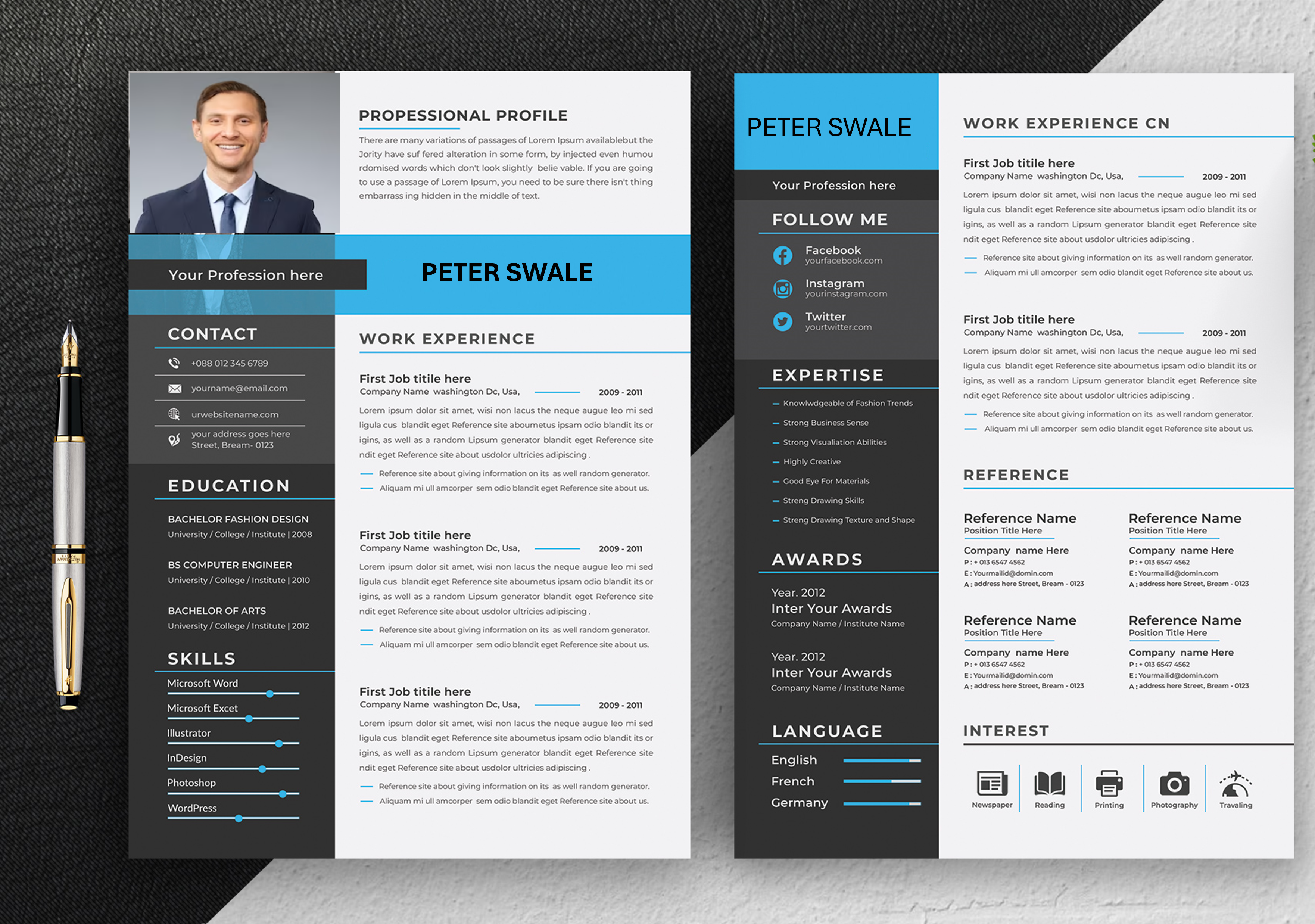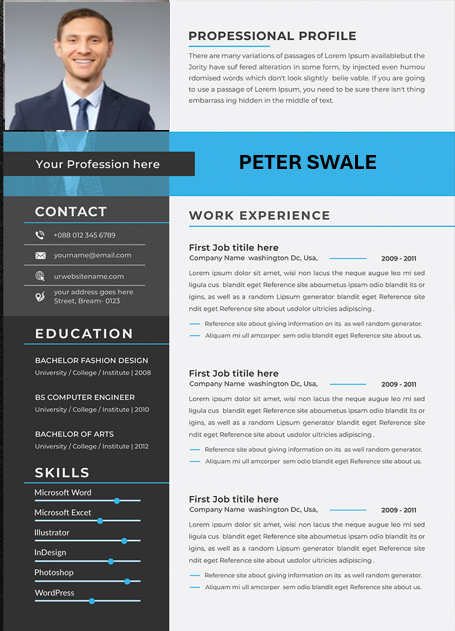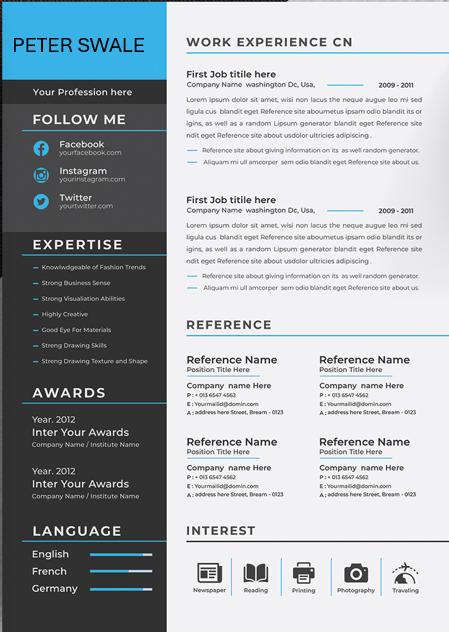Save time and Make a lasting impression with our fully Editable Farming, Animals & Conservation Resume | CV
Download ATS-optimized resumes that yield favorable outcomes for a diverse range of positions, spanning from entry-level to professional and executive roles.
This Construction Resume/CV Template is well organized and structured Images, texts and colors are fully editable.
Beat the Applicant Tracking Systems with precision-crafted resumes.
Tailored to highlight your unique skills and experiences.
Targeted resumes for your dream positions.
For every purchase, the document comes with FREE tips to polish your interview skills and boost your confidence.
➡ Global Network: Partnered with +20 Resume Writing and Recruitment agencies across the USA, Canada, Australia, Europe and aFRICA.
📊 ATS Report: +80% Job Scan ATS reports for optimized resumes.
💼 Interview Mastery: Resources like Job Interview Guides, Thank You Letters, and a References Page for success.
🌟 Instant Download
✪ Resume Rewrite
✔ Modern, ATS-friendly design from scratch.
✔ Compelling summary targeting your next roles.
✔ Skills/Expertise section for increased visibility.
✪ Cover Letter
✔ One-page cover letter for applications.
✔ Convey why you’re the perfect fit.
✔ Demonstrate how your skills add value.
Transform your career with this limited-time offer
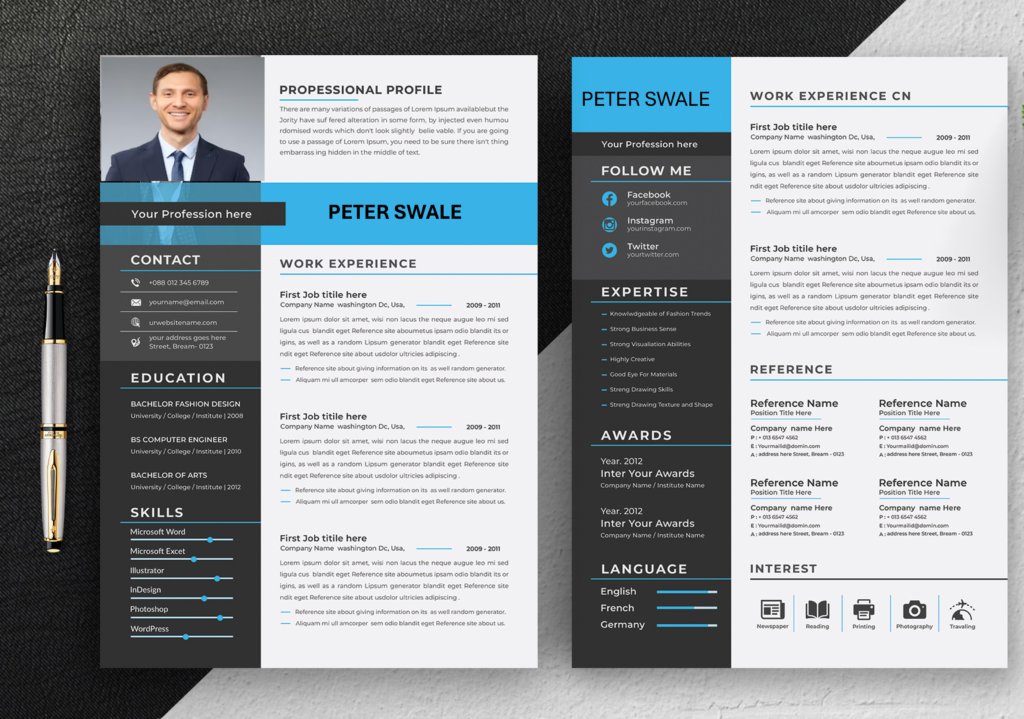
$2 USD
$ 25.00 USD
30-Day Money-Back Guarantee
About this Resume:
Fully Editable
89 Users
Instant Download
MS Word, PDF, PSD, AI
Testimonial

4.9 star ratings
from over
1178 Users
Trade the stress of crafting your resume with confidence and clarity, empowering you to secure your dream job.
Farming, Animals & Conservation Resume Templates FAQs
See our Farming, Animals & Conservation Resume examples here
Passionate and dedicated conservation biologist with over 8 years of experience in wildlife research, habitat conservation, and environmental education. Skilled in fieldwork, data collection, and analysis, with a strong commitment to biodiversity conservation and sustainable land management practices. Experienced in working with diverse stakeholders, including government agencies, non-profit organizations, and local communities, to develop and implement conservation initiatives. Proven track record of successfully managing projects, conducting research, and effectively communicating findings to both scientific and lay audiences. Seeking to leverage expertise in farming, animals, and conservation to contribute to the protection and preservation of natural ecosystems and wildlife populations.
Here’s a sample structure for a Farming, Animals & Conservation Resume:
-
Header:
- Name
- Contact Information (Phone Number, Email Address)
- Location (City, State)
-
Summary/Objective:
- Brief overview of your background, skills, and career goals in farming, animals, and conservation. Tailor this section to highlight your specific strengths and objectives.
-
Professional Experience:
- List your relevant work experience in reverse chronological order.
- Include job titles, organization names, locations, and dates of employment.
- Use bullet points to describe your responsibilities and achievements in each role, focusing on tasks related to farming practices, animal husbandry, conservation research, habitat restoration, community engagement, and environmental education.
-
Education:
- List your educational qualifications in reverse chronological order.
- Include degrees, certifications, and any relevant coursework or academic projects.
- Specify the name of the institution, location, degree obtained, and graduation date.
-
Skills:
- Highlight key skills relevant to farming, animals, and conservation roles, such as:
- Farm management and agriculture practices
- Animal care and husbandry
- Wildlife research and conservation
- Habitat restoration and land management
- Environmental education and outreach
- Data collection and analysis
- Project management
- Community engagement and stakeholder collaboration
- Tailor your skills section to match the requirements of the job you’re applying for.
- Highlight key skills relevant to farming, animals, and conservation roles, such as:
-
Certifications and Training:
- Include any relevant certifications or training programs you’ve completed, such as:
- Certified Wildlife Biologist (CWB)
- Sustainable Agriculture Certification
- Permaculture Design Course (PDC)
- First Aid/CPR Certification
- Provide the name of the certification/training program, issuing organization, and date obtained.
- Include any relevant certifications or training programs you’ve completed, such as:
-
Projects:
- Optional section to highlight relevant projects you’ve worked on, either during your academic studies or in professional roles. Include a brief description of each project, your role and responsibilities, and any notable outcomes or achievements.
-
Professional Affiliations:
- Optional section to list memberships in relevant farming, animals, and conservation organizations or associations, such as the National Audubon Society, World Wildlife Fund (WWF), etc.
-
Additional Sections (Optional):
- Awards and Honors: Recognition for achievements in the field of farming, animals, and conservation.
- Publications: Any research papers, articles, or reports you’ve authored or co-authored.
- Volunteer Work: Any relevant volunteer experience related to farming, animals, and conservation or community involvement.
- Languages: Fluency in languages other than English may be beneficial, especially for roles involving international conservation projects.
-
References:
- You can include “References available upon request” at the bottom of your resume. Make sure you have a separate list of references prepared if requested by the employer.
By following this structure and customizing the content to match your own experiences and qualifications, you can create a compelling Farming, Animals & Conservation resume that effectively showcases your expertise and suitability for roles in these fields.
Our resume writing service has helped applicants land more interviews and get hired faster.
Other Questions On Farming, Animals & Conservation Resume Services
The main goal of a resume is to secure interviews for you. If you’re not getting the desired responses or interview invitations from your job applications, chances are your resume isn’t effectively showcasing your qualifications. Our resume writing services are tailored to align your experience, skills, and strengths with your target positions, ensuring you stand out to potential employers.
The objective is to convey your value to potential employers effectively. Usually, clients experience a significant surge in interview requests with a professionally crafted, targeted resume.
A professional Farming, Animals & Conservation resume writer can help you get the job you want in several ways:
-
Highlighting Relevant Experience: They will emphasize your relevant experience in farming, animals, and conservation, ensuring your resume effectively showcases your skills, accomplishments, and contributions in areas such as farm management, animal husbandry, wildlife research, habitat conservation, and environmental education.
-
Optimizing Keywords: Professional resume writers understand the importance of including relevant keywords in your resume to ensure it gets past applicant tracking systems (ATS) and reaches human reviewers. They will optimize your resume with industry-specific keywords and formatting to improve its visibility.
-
Showcasing Achievements: They will help you identify and highlight your achievements in previous roles, such as implementing sustainable farming practices, conducting research on endangered species, leading habitat restoration projects, and engaging with local communities to promote conservation efforts. This helps demonstrate your impact and value to potential employers.
-
Tailoring Resumes to Specific Roles: Professional resume writers will tailor your resume to match the specific requirements of the farming, animals, and conservation job you’re applying for, ensuring it highlights the skills and experiences most relevant to the position and organization.
-
Emphasizing Soft Skills: In addition to technical skills, farming, animals, and conservation roles often require strong interpersonal skills, communication abilities, teamwork, and a passion for environmental stewardship. A professional resume writer will help you effectively showcase these soft skills in your resume to demonstrate your suitability for the role.
-
Providing Expert Advice and Guidance: Throughout the resume writing process, a professional resume writer will provide expert advice and guidance, helping you make strategic decisions about the content, format, and presentation of your resume to maximize its impact and relevance to potential employers.
-
Increasing Confidence: Having a professionally written resume can increase your confidence in your job search efforts, knowing that your resume effectively represents your skills, experiences, and qualifications to potential employers in the farming, animals, and conservation fields.
Overall, working with a professional Farming, Animals & Conservation resume writer can significantly enhance your job search efforts and increase your chances of landing the job you want in these rewarding and impactful fields. They can help you stand out from the competition and position yourself as a top candidate with a strong commitment to environmental sustainability and conservation.
Optimizing your LinkedIn profile can significantly increase your visibility to recruiters and potential employers. Here are some tips to help you optimize your LinkedIn profile and improve your chances of being found by recruiters:
-
Complete Your Profile: Fill out all sections of your LinkedIn profile, including your summary, work experience, education, skills, and interests. A complete profile provides more information for recruiters to assess your qualifications and suitability for roles.
-
Use Keywords Strategically: Incorporate relevant keywords throughout your profile, including in your headline, summary, job titles, and skills section. Use keywords that are commonly used in your industry and by recruiters searching for candidates with your skill set.
-
Craft a Compelling Headline: Your LinkedIn headline appears prominently below your name and should effectively summarize your professional identity and expertise. Use keywords related to your desired role or industry to attract the attention of recruiters.
-
Write a Captivating Summary: Use the summary section to provide a brief overview of your background, skills, experience, and career goals. Showcase your unique value proposition and highlight your key achievements and strengths. Use a conversational tone to engage readers and make your profile more appealing.
-
Highlight Your Accomplishments: In the experience section, focus on highlighting your accomplishments and contributions in each role rather than just listing your job responsibilities. Use quantifiable achievements and metrics whenever possible to demonstrate your impact.
-
Add Multimedia Content: LinkedIn allows you to enhance your profile with multimedia content such as links to articles, presentations, videos, or projects. Incorporate relevant multimedia content to showcase your work and provide additional context to recruiters.
-
Request Recommendations: Request recommendations from colleagues, managers, or clients who can vouch for your skills and professionalism. Authentic recommendations add credibility to your profile and reinforce your qualifications.
-
Grow Your Network: Connect with professionals in your industry, including recruiters, hiring managers, and colleagues. Building a strong network expands your visibility and increases the likelihood of being discovered by recruiters.
-
Engage with Content: Like, comment on, and share relevant posts and articles to demonstrate your expertise and engage with your network. Active engagement helps to increase your visibility and establish your presence as a thought leader in your field.
-
Enable Open to Work Feature: LinkedIn offers an “Open to Work” feature that allows you to signal to recruiters that you are actively seeking new opportunities. Enable this feature in your profile settings to make it easier for recruiters to identify you as a potential candidate.
By implementing these strategies, you can optimize your LinkedIn profile and increase your visibility to recruiters, ultimately improving your chances of being contacted for relevant job opportunities.
A successful Farming, Animals & Conservation resume typically includes the following components:
-
Header:
- Name
- Contact Information (Phone Number, Email Address)
- Location (City, State)
-
Summary/Objective:
- Brief overview of your background, skills, and career goals in farming, animals, and conservation. Tailor this section to highlight your specific strengths and objectives.
-
Professional Experience:
- List your relevant work experience in reverse chronological order.
- Include job titles, organization names, locations, and dates of employment.
- Use bullet points to describe your responsibilities and achievements in each role, focusing on tasks related to farming practices, animal husbandry, wildlife research, habitat conservation, and environmental education.
-
Education:
- List your educational qualifications in reverse chronological order.
- Include degrees, certifications, and any relevant coursework or academic projects.
- Specify the name of the institution, location, degree obtained, and graduation date.
-
Skills:
- Highlight key skills relevant to farming, animals, and conservation roles, such as:
- Farm management and agriculture practices
- Animal care and husbandry
- Wildlife research and conservation
- Habitat restoration and land management
- Environmental education and outreach
- Data collection and analysis
- Project management
- Community engagement and stakeholder collaboration
- Tailor your skills section to match the requirements of the job you’re applying for.
- Highlight key skills relevant to farming, animals, and conservation roles, such as:
-
Certifications and Training:
- Include any relevant certifications or training programs you’ve completed, such as:
- Sustainable Agriculture Certification
- Certified Wildlife Biologist (CWB)
- Permaculture Design Course (PDC)
- First Aid/CPR Certification
- Provide the name of the certification/training program, issuing organization, and date obtained.
- Include any relevant certifications or training programs you’ve completed, such as:
-
Projects:
- Optional section to highlight relevant projects you’ve worked on, either during your academic studies or in professional roles. Include a brief description of each project, your role and responsibilities, and any notable outcomes or achievements.
-
Professional Affiliations:
- Optional section to list memberships in relevant farming, animals, and conservation organizations or associations, such as the National Audubon Society, World Wildlife Fund (WWF), etc.
-
Additional Sections (Optional):
- Awards and Honors: Recognition for achievements in the field of farming, animals, and conservation.
- Publications: Any research papers, articles, or reports you’ve authored or co-authored.
- Volunteer Work: Any relevant volunteer experience related to farming, animals, and conservation or community involvement.
- Languages: Fluency in languages other than English may be beneficial, especially for roles involving international conservation projects.
-
References:
- You can include “References available upon request” at the bottom of your resume. Make sure you have a separate list of references prepared if requested by the employer.
By including these components and customizing the content to match your own experiences and qualifications, you can create a compelling Farming, Animals & Conservation resume that effectively showcases your expertise and suitability for roles in these fields.
If you’re looking for a “professional farming, animals & conservation resume writer near you”, here are 3 reasons when it makes perfect sense to do so.
- You’re currently employed and seeking new job opportunities.
- Your resume requires refinement Not Writing From Scratch
-
You’re in need of securing employment swiftly.

